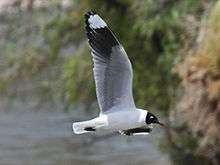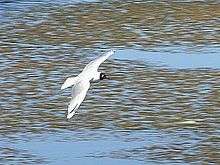Andean gull
| Andean gull | |
|---|---|
 | |
| Breeding plumage, Peru | |
| Scientific classification | |
| Kingdom: | Animalia |
| Phylum: | Chordata |
| Class: | Aves |
| Order: | Charadriiformes |
| Family: | Laridae |
| Genus: | Chroicocephalus |
| Species: | C. serranus |
| Binomial name | |
| Chroicocephalus serranus (Tschudi, 1844) | |
| Synonyms | |
|
Larus serranus | |
The Andean gull (Chroicocephalus serranus) is a species of gull in the family Laridae. As is the case with many gulls, it has traditionally been placed in the genus Larus. It is found in the Andes in mountainous regions of Argentina, Bolivia, Chile, Colombia, Ecuador, and Peru. It is unusual for a gull in that it breeds inland in mountain areas. It may be variously found around rivers, freshwater lakes, saline marshes, and pastureland.
Description
At 45–48 cm (18–19 in) long, it is large for a black-headed gull (it is the largest gull with that kind of plumage in the Americas). It is the largest species in the genus Chroicocephalus and has a dark hood, a pale grey back and a pattern of black and white on its primaries.[2]
Distribution and habitat
The Andean gull is known from Chile, Peru, Argentina, Bolivia, Ecuador and Colombia where it breeds in mountainous areas, usually at elevations of over 3,000 metres (9,800 ft). In areas with harsh winters it migrates to lower elevations in winter, sometimes as far as the coast. Flocks of these gulls are common on the coast in southern Peru and northern Chile, but It has yet to be established where these particular birds breed. In the wetlands of the Altiplano it is resident and breeds at 4,000 metres (13,000 ft) while in southern Argentina it may breed at as little as 2,000 metres (6,600 ft) but this is in similar habitats to the birds further north. The Andean Gull nests in small scattered colonies, sometimes even as solitary pairs, in small, isolated ponds. Unusually for a gull of this size, it becomes sexually mature at the age of two years rather than three.[2]
It feeds on a variety of prey items, including insects and worms taken on fields and grasslands; it also sometimes catches aerial insects and eats some garbage when available.
Gallery
 Nonbreeding plumage, Peru
Nonbreeding plumage, Peru Breeding plumage
Breeding plumage Gulls in Southern Bolivia
Gulls in Southern Bolivia
| Wikimedia Commons has media related to Larus serranus. |
References
- ↑ BirdLife International (2016). "Chroicocephalus serranus". IUCN Red List of Threatened Species. Version 2017.3. International Union for Conservation of Nature. Retrieved 12 February 2018.
- 1 2 "Chroicocephalus serranus". Neotropical Birds Online. Cornell Lab of Ornithology. Retrieved 12 December 2013.
- "The Birds of Ecuador" by Robert S. Ridgely & Paul Greenfield. Cornell University Press (2001), ISBN 978-0-8014-8722-4.
- Pons, J.M.; Hassanin, A.; Crochet, P.A. (2005). "Phylogenetic relationships within the Laridae (Charadriiformes: Aves) inferred from mitochondrial markers". Molecular Phylogenetics and Evolution. 37 (3): 686–699.
